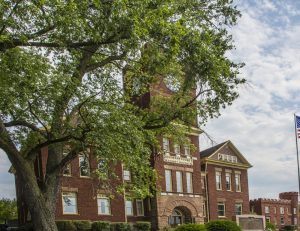Michigan’s Baby County
Let’s rewind to May 21, 1891—a day that marked the end of county-making in Michigan’s history books. On this day, the state officially established its 83rd and final county: Dickinson County, carved from parts of Marquette, Menominee, and Iron counties in the Upper Peninsula. Youngest in the lineup but rich in industry and heritage, Dickinson County tells a story of iron, lumber, politics, and perseverance.
Named after Donald M. Dickinson, who served as U.S. Postmaster General under President Grover Cleveland, the county was created by Public Act 89 of 1891, which was signed into law on May 21 and became effective on October 2 that same year. While Dickinson may not have the centuries of history its older siblings boast, it quickly made a name for itself.
Iron Mines
Before its official formation, the area already played a key role in Michigan’s growth. The Menominee Iron Range, discovered in the 1870s, was a gold mine—well, technically an iron mine—of economic potential. Iron Mountain, now the county seat, was the site of one of the richest iron ore deposits in the world. Ore shipments began rolling out in 1877, cementing the area as an industrial powerhouse.
But Dickinson County wasn’t just about what lay beneath the surface. The Breen brothers began logging operations in the 1860s, and the region’s vast forests supported a thriving lumber trade. Today, it continues to offer natural riches—think scenic lakes, excellent fishing, wildlife galore, and landmarks like the Chapin Mine and Pine Mountain, home to the highest artificial ski jump in the world.
From humble lumber beginnings to record-breaking ski jumps, Dickinson County has packed quite a story into its 130+ years. As Michigan’s “baby” county, it serves as a reminder that sometimes the youngest sibling still gets to have all the fun.
So here’s to Dickinson—officially born on this day in 1891, and still making its mark.
Dickinson County/Dickinson County Courthouse and Jail Historical Marker
Industry and Invention (1875-1915) – Registered in 1977 and erected in 1999 – ID #L563
Located at 700 South Stephenson, Iron Mountain, Breitung Township – Lat: 45.81605800 / Long: -88.06400200
 Dickinson County
Dickinson County
In 1873 John Lane Buell exposed one of the richest deposits of iron ore in the world. His discovery, known as the Menominee Iron Range, led to the development of the area and the subsequent creation of Dickinson County in 1891. The last of Michigan’s eighty-three counties to be organized, it was named for Donald M. Dickinson, a prominent Detroit attorney and postmaster general in the first administration of President Grover Cleveland (1885-1889). Three of Michigan’s largest iron mines were located in Iron Mountain, which had an abundant supply of water power and was served by two major railroads. Iron Mountain became a center of commerce and distribution for the range and was the natural location for the county seat once the county was organized.
Dickinson County Courthouse and Jail
This Richardsonian Romanesque courthouse, erected in 1896 97, is constructed of rock faced brick, trimmed with Portage Entry sandstone. James E. Clancy, a locally recognized architect who specialized in planning public buildings on the Menominee Iron Range, designed the courthouse. County offices opened here only five years after Dickinson County was created by act of the Michigan State Legislature. The jail, designed to complement the larger structure, originally had thirty four cells for male prisoners and two wards for juvenile and female prisoners on the first floor, with the sheriff’s quarters on the first and second floors. County offices moved into the building in 1982.
Learn more about the rich history of the Central Upper Peninsula.


